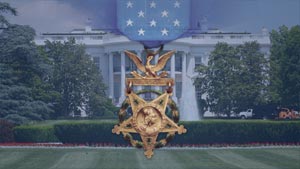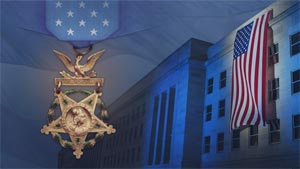MEDAL OF HONOR
Vietnam WarCaptain Hugh R. Nelson Jr.

hometown
Tuscaloosa, Alabama
Date of commission
September 1963
Military Occupation (MOS)
Cargo Helicopter Pilot (100C)
Unit
114th Aviation Company (Airmobile Light)
Deployments
Vietnam War, 1966
Hugh Reavis Nelson Jr. was born July 11, 1937, to Army Air Corps Lt. Col. Hugh Reavis Nelson Sr. and Sarah Beth Burnett (Diddy) Nelson in Tuscaloosa, Alabama. Lt. Col. Nelson was a barnstormer and flight instructor.
Hugh had a younger brother, Joseph Reed Peter Nelson, and sister, Frances Barbara Nelson McComas Rowe (deceased). He graduated from Durham High School in 1955, where he played football and ran track, placing third in the state championship his senior year, and belonged to other clubs and organizations.
He graduated from The Citadel in Charleston, South Carolina, in 1959 and married Elizabeth Ann Dees on July 22, 1959. They had three children: Debra Ann, Margaret Dees and Hugh Reavis Nelson III.
Capt. Nelson was stationed in Taiwan for three years, then reported for duty in Vietnam on Jan. 2, 1966. He died June 5, 1966.
 Capt. Hugh Nelson Jr. pictured with his daughter Debbie McKnight. Courtesy photo.
Capt. Hugh Nelson Jr. pictured with his daughter Debbie McKnight. Courtesy photo.
The Battle
Protecting a fellow soldier's life at the cost of his own
June 5, 1966 | Near Moc Hoa, Republic of Vietnam

114th Aviation Company (Airmobile Light)
Distinctive unit insignia of the 114th Aviation Company. Read Full Unit History
Capt. Hugh R. Nelson, Jr., distinguished himself by conspicuous gallantry and intrepidity above and beyond the call of duty while serving as a member of the 114th Aviation Company (Airmobile Light) on June 5, 1966, near Moc Hoa, Republic of Vietnam. Nelson was the acting aircraft commander of a Huey helicopter on a search-and-destroy reconnaissance mission when it was struck by a large volume of enemy fire that rendered the aircraft virtually uncontrollable.
With great difficulty, Nelson and the pilot were able to crash-land the aircraft without lateral controls. At some point after the crash, Nelson exited the aircraft and went to the aid of his wounded comrades. Proceeding to the other side of the aircraft, he found his dazed and wounded crew chief still trapped inside. After removing the specialist and placing him on the ground, Nelson climbed into the severely damaged helicopter to assist the door gunner, who was still strapped inside and unable to move.
While Nelson tried to free his comrade, the insurgents engaged the aircraft with a heavy volume of automatic rifle and small-arms fire at a range of approximately thirty feet from the aircraft. Despite the heavy enemy fire, Nelson continued his gallant efforts, freeing the trapped door gunner despite being hit by enemy fire. Upon removing the wounded door gunner from the aircraft, he forced the specialist to the ground and, without regard for his own life, used his body as a shield to cover his comrade from the intense enemy fire. Nelson was hit several times as he sacrificed his own life to save his comrade.
His selfless sacrifice allowed his wounded comrade to use a smoke grenade to signal supporting aircraft in the area that there were crash survivors. The supporting aircraft responded immediately, preventing the insurgents from advancing on the downed aircraft and successfully rescuing the three wounded crew members.
Nelson's conscious decision to sacrifice his own life for that of his comrades saved the lives of his three fellow crew members that fateful day. Nelson's distinctive accomplishments are in keeping with the highest traditions of military service and reflect great credit upon him, his unit and the United States Army.
 Artifacts retrieved from Capt. Nelson's wallet. Clockwise, starting from the left: Nine Rules for Personnel of The U.S. Military, a guide to aviation briefing and formula calculator, personal identification and command and signal guidance. Courtesy photo.
Artifacts retrieved from Capt. Nelson's wallet. Clockwise, starting from the left: Nine Rules for Personnel of The U.S. Military, a guide to aviation briefing and formula calculator, personal identification and command and signal guidance. Courtesy photo.
RELATED STORIES FROM ARMY.MIL
114th Aviation Company (Airmobile Light)

Distinctive unit insignia of the 114th Aviation Company, featuring a winged horse-head chess piece, a nod to the motto "Knights of the Air."
The company was first activated at Fort Sill, Oklahoma, in 1956 as the 64th Transportation Company (Light Helicopter). Members of the unit completed H-34 transition in July 1956. In August and September 1956, the 1st platoon was on temporary duty at Fort Carson and Camp Hale, Colorado, undergoing cold-weather and mountain-flying training. While there, the platoon participated in Operation Cold Spot with two battalions of the 1st Infantry Division from Fort Riley, Kansas. On Dec. 6, 1956, the 64th Transportation Company and the 544th Transportation Detachment (CHFM) were transferred to Fort Hood, Texas. On Feb. 1, 1958, after little more than a year at Fort Hood, both the 64th Transportation Company and the 544th Transportation Detachment were again transferred – this time to Fort Knox, Kentucky. Soon afterwards, the 64th Transportation Company was deactivated and reactivated as C Troop (Air), 17th Cavalry.
Effective Jan. 16, 1963, under the provisions of General Order Number 6, Headquarters United States Army Armor Center, Fort Knox, Kentucky, C Troop (Air), 17th Cavalry, was deactivated and reactivated as the 114th Air Mobile Company. On Feb. 8, 1963, under the provisions of General Order Number 15, Headquarters United States Army Armor Center, Fort Knox, Kentucky, the 96th Signal Detachment (Avionics Maintenance) was activated and attached to the 114th Air Mobile Company. Effective March 16, 1963, under the provisions of General Order Number 33, Headquarters United States Army Armor Center School Troops, Fort Knox, Kentucky, the 83rd Medical Detachment was attached to the 114th Air Mobile Company. Effective May 7, 1963, the 114th Air Mobile Company, the 96th Signal Detachment and the 544th Transportation Detachment were assigned to the United States Army Support Group, Vietnam, and officially arrived at Vinh Long, Republic of South Vietnam, on May 10, 1963.
In July 1963, the 114th Air Mobile Company at Vinh Long joined with the 93rd Transportation Company (Light Helicopter) at Soc Trang and became part of the newly constituted Delta Aviation Battalion (Provisional) headquartered at Can Tho. Effective June 4, 1964, under the provisions of General Order Number 17, Headquarters United States Army Pacific, the 114th Air Mobile Company was redesigned the 114th Aviation Company (Air Mobile Light). On Sept. 30, 1964, the 114th Aviation Company (Air Mobile Light) was assigned to the 13th Aviation Battalion (Combat), the successor of the Delta Aviation Battalion (Provisional). On July 2, 1966, under the provisions of General Order Number 41, Headquarters United States Army Vietnam, the 114th Aviation Company (Air Mobile Light) came under the control of the 1st Aviation Brigade, United States Army Vietnam, and was redesignated the 114th Assault Helicopter Company. In October 1969, the 114th Assault Helicopter Company was released from assignment to the 13th Aviation Battalion (Combat) and reassigned to the 214th Aviation Battalion (Combat). On the Feb. 29, 1972, the 114th Assault Helicopter Company ended its nine-year tour of duty at Vinh Long. Departing the Republic of South Vietnam on Feb. 29, 1972, the 114th Aviation Company was assigned to Panama, where it served with distinction, including involvement in many mercy missions and disaster-relief operations. The 114th was deactivated at Fort Clayton, Panama Canal Zone, in October 1987.

